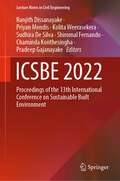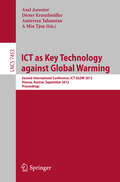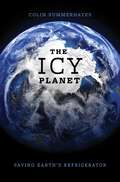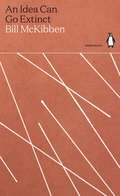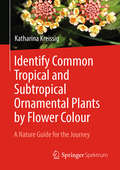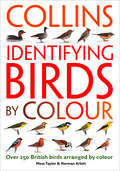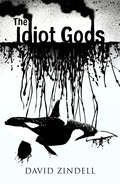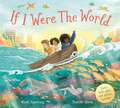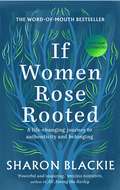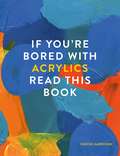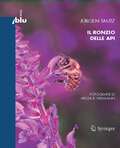- Table View
- List View
ICSBE 2022: Proceedings of the 13th International Conference on Sustainable Built Environment (Lecture Notes in Civil Engineering #362)
by Ranjith Dissanayake Priyan Mendis Kolita Weerasekera Sudhira De Silva Shiromal Fernando Chaminda Konthesingha Pradeep GajanayakeThis book highlights the latest knowledge and innovations in the fields of civil engineering and construction industry striving for a sustainable built environment. It consists of high quality and innovative research findings selected from the proceedings of the 13th ICSBE 2022 under the themes of sustainable construction, urban green infrastructure and planning, rainwater harvesting and water conservation, high-performance concrete, indoor environmental quality and indoor plants, wind and hydro-power energy, waste and wastewater management for enhanced sustainability, impacts of climate change, carbon footprint, global climate model and landscaping, material flows and industrial ecology, sustainable materials, etc.
ICT as Key Technology against Global Warming: Second International Conference, ICT-GLOW 2012, Vienna, Austria, September 6, 2012, Proceedings (Lecture Notes in Computer Science #7453)
by Axel Auweter Dieter Kranzlmüller Amirreza Tahamtan A. Min TjoaThis book constitutes the refereed proceedings of the Second International Conference on ICT as Key Technology for the Fight against Global Warming, ICT-GLOW 2012, held in Vienna, Austria, in September 2012, in conjunction with DEXA 2012. The 9 revised papers presented were carefully reviewed and selected for inclusion in the volume. They are organized in the following topical sections: novel implementations for energy awareness; green data centers and supercomputing; and green organization and business modelling.
The Icy Planet: Saving Earth's Refrigerator
by Colin SummerhayesFor most people, planet Earth's icy parts remain out of sight and out of mind. Yet it is the melting of ice that will both raise sea level and warm the climate further by reducing the white surfaces that reflect solar energy back into space. In effect, our icy places act as the world's refrigerator, helping to keep our climate relatively cool. The Icy Planet lays out carbon dioxide's role as the control knob of our climate over the past 1000 million years, then explores what is happening to ice and snow in Antarctica, the Arctic and the high mountains. Colin Summerhayes takes readers to the world's icy places to see what is happening to its ice, snow, and permafrost. He recounts tales from his own visits to these frozen landscapes, shining a light on some of the wonders he has encountered in his travels. He also brings together pieces of the climate story from different scientific disciplines, and from the past and the present, to illustrate how Earth's climate system works. Utilizing geological records of climate change alongside new technologies in ice coring, Summerhayes crafts a detailed and compelling record of Earth's climate history and examines how that can be used as a window into our future.
The Icy Planet: Saving Earth's Refrigerator
by Colin SummerhayesFor most people, planet Earth's icy parts remain out of sight and out of mind. Yet it is the melting of ice that will both raise sea level and warm the climate further by reducing the white surfaces that reflect solar energy back into space. In effect, our icy places act as the world's refrigerator, helping to keep our climate relatively cool. The Icy Planet lays out carbon dioxide's role as the control knob of our climate over the past 1000 million years, then explores what is happening to ice and snow in Antarctica, the Arctic and the high mountains. Colin Summerhayes takes readers to the world's icy places to see what is happening to its ice, snow, and permafrost. He recounts tales from his own visits to these frozen landscapes, shining a light on some of the wonders he has encountered in his travels. He also brings together pieces of the climate story from different scientific disciplines, and from the past and the present, to illustrate how Earth's climate system works. Utilizing geological records of climate change alongside new technologies in ice coring, Summerhayes crafts a detailed and compelling record of Earth's climate history and examines how that can be used as a window into our future.
ID Handbook of European Birds
by Nils van DuivendijkA groundbreaking two-volume illustrated reference book covering all of Europe&’s birdsWould you like to be able to identify any bird species in Europe, in all plumages, in every season? ID Handbook of European Birds is the resource for you. This identification handbook blends incisive descriptions with stunning high-resolution photos to provide the most comprehensive, in-depth coverage of European birds available. Never before has so much current information been brought together in one place and presented so clearly and completely. This monumental two-volume work is destined to become a standard reference to Europe&’s birds.Covers 733 species known to occur in EuropeFeatures more than 5,500 spectacular color photosDetailed species accounts describe key identification features, molting, age, and genderThe high-quality photos depict the characteristics most essential for identificationInnovatively designed for easy, at-a-glance referenceAn ideal resource for anyone who wants to enhance their experience in the fieldA must for bird-watchers everywhere, from beginners to seasoned birders
An Idea Can Go Extinct (Green Ideas)
by Bill McKibbenIn twenty short books, Penguin brings you the classics of the environmental movement.An Idea Can Go Extinct is Bill McKibben's impassioned, groundbreaking account of how, by changing the earth's entire atmosphere, the weather and the most basic forces around us, 'we are ending nature.'Over the past 75 years, a new canon has emerged. As life on Earth has become irrevocably altered by humans, visionary thinkers around the world have raised their voices to defend the planet, and affirm our place at the heart of its restoration. Their words have endured through the decades, becoming the classics of a movement. Together, these books show the richness of environmental thought, and point the way to a fairer, saner, greener world.
The ideal river: How control of nature shaped the international order
by Joanne YaoEnvironmental politics has traditionally been a peripheral concern for international relations theory, but increasing alarm over global environmental challenges has elevated international society’s relationship with the natural world into the theoretical limelight. IR theory’s engagement with environmental politics, however, has largely focused on interstate cooperation in the late twentieth century, with less attention paid to how the eighteenth- and nineteenth-century quest to tame nature came to shape the modern international order.The ideal river examines nineteenth-century efforts to establish international commissions on three transboundary rivers – the Rhine, the Danube, and the Congo. It charts how the Enlightenment ambition to tame the natural world, and human nature itself, became an international standard for rational and civilized authority and informed our geographical imagination of the international. This relationship of domination over nature shaped three core IR concepts central to the emergence of early international order: the territorial sovereign state; imperial hierarchies; and international organizations. The book contributes to environmental politics and international relations by highlighting how the relationship between society and nature is not a peripheral concern, but one at the heart of international politics.
The ideal river: How control of nature shaped the international order
by Joanne YaoEnvironmental politics has traditionally been a peripheral concern for international relations theory, but increasing alarm over global environmental challenges has elevated international society’s relationship with the natural world into the theoretical limelight. IR theory’s engagement with environmental politics, however, has largely focused on interstate cooperation in the late twentieth century, with less attention paid to how the eighteenth- and nineteenth-century quest to tame nature came to shape the modern international order.The ideal river examines nineteenth-century efforts to establish international commissions on three transboundary rivers – the Rhine, the Danube, and the Congo. It charts how the Enlightenment ambition to tame the natural world, and human nature itself, became an international standard for rational and civilized authority and informed our geographical imagination of the international. This relationship of domination over nature shaped three core IR concepts central to the emergence of early international order: the territorial sovereign state; imperial hierarchies; and international organizations. The book contributes to environmental politics and international relations by highlighting how the relationship between society and nature is not a peripheral concern, but one at the heart of international politics.
Ideas to Postpone the End of the World
by Ailton Krenak“Ailton Krenak’s ideas inspire, washing over you with every truth-telling sentence. Read this book.” — Tanya Talaga, bestselling author of Seven Fallen FeathersIndigenous peoples have faced the end of the world before. Now, humankind is on a collective march towards the abyss. Global pandemics, extreme weather, and massive wildfires define this era many now call the Anthropocene.From Brazil comes Ailton Krenak, renowned Indigenous activist and leader, who demonstrates that our current environmental crisis is rooted in society’s flawed concept of “humanity” — that human beings are superior to other forms of nature and are justified in exploiting it as we please.To stop environmental disaster, Krenak argues that we must reject the homogenizing effect of this perspective and embrace a new form of “dreaming” that allows us to regain our place within nature. In Ideas to Postpone the End of the World, he shows us the way.
Identification of tropical woody plants in the absence of flowers and fruits: A field guide
by Roland KellerWhile studies of forest vegetation may differ in their underlying objective, be it physiology, ecology or biodiversity, common to all these is the fact that all require taxonomic knowledge. The process of taxon omy or of forest ecology begins in principle with an inventory of the flora, the evaluation of this inven tory still being based to a large extent of reproduction-related organs. In a tropical forest, the majority of flowers or fruits are most often found in the canopy. The canopy, however, is difficult to reach and to do so necessitates heavy, expensive or sophisticated equipment such as a tower, a crane, or a hanging platform suspended from a dirigible balloon. Thus, most of the time, botany is practised near the ground with the aid of light equipment such as ladders, branch loppers, and climbing irons. Furthermore, a large proportion of the trees and lianas of the understorey bear neither flowers nor fruits at certain times of the year. Despite this absence of seasonal characters it should at least be possible to recognize the families of plants by means of easily observable and permanent characters. To meet this need, an identification system has been designed in the form of a dichotomous key. In addition to permitting recognition ofplantfamities in the field in all seasons, this system can serve as a starting-point for a more detailed knowledge of the forest taxa.
Identify Common Tropical and Subtropical Ornamental Plants by Flower Colour: A Nature Guide for the Journey
by Katharina KreissigThis book is a practical, compact guide for the identification of common tropical and subtropical ornamental plants by flower colour. It is intended for anyone who is interested in plants and would like to get to know the attractive flowering plants of warm regions while travelling. Certainly everyone in a foreign country has at some point admired a particularly exotic flower and wished to know which plant it is. With appealing photos and comprehensible texts, this book provides the answer - quickly and easily. The author is an experienced tour guide and is regularly asked for eye-catching, ornamental plants on the way. She photographed the frequently requested plants and arranged them according to colour in this nature guide. This book is also suitable for beginners without previous botanical knowledge due to its illustrations and simple sorting.
Identifying Birds by Colour
by Norman Arlott Moss TaylorOptimised for devices with colour screens. A unique spotter's guide for the first-time birdwatcher.
Identifying Emerging Issues in Disaster Risk Reduction, Migration, Climate Change and Sustainable Development: Shaping Debates and Policies
by Karen Sudmeier-Rieux Manuela Fernández Ivanna M. Penna Michel Jaboyedoff J. C. GaillardThe goal of this book is to explore disaster risk reduction (DRR), migration, climate change adaptation (CCA) and sustainable development linkages from a number of different geographical, social and natural science angles. Well-known scientists and practitioners present different perspectives regarding these inter-linkages from around the world, with theoretical discussions as well as field observations. This publication contributes in particular to the discussion on the Sendai Framework for Disaster Risk Reduction (SFDRR) 2015-2030 and the debate about how to improve DRR, including CCA, policies and practices, taking into account migration processes from a large perspective where both natural and social factors are crucial and mutually “alloyed”. Some authors see the SFDRR as a positive step forward in terms of embracing a multitude of issues, others doubting that the agreement will lead to much concrete action toward real action on the ground. This book is a timely contribution for researchers, students and policy makers in the fields of environment, human geography, migration, disaster and climate change studies who seek a more comprehensive grasp of contemporary development issues.
Identifying Migratory Birds by Sound in Britain and Europe
by Stanislas WrozaIdentify migratory birds with this book, containing detailed text on flight and contact calls, annotated sonograms and QR codes to the calls themselves. Every spring and autumn, millions of birds fly over us to en route to their summer or winter quarters, with these migratory flights occurring both day and night. A profusion of sounds fills the air, making it possible to put a name to these fleeting silhouettes - because the best way to identify these migrants is by their calls. Often neglected in traditional identification guides, these calls are described in this book with precision. Annotated sonograms make it possible to visualise, identify and better memorise the flight and contact calls of British and European migratory species. * Describes 450 species, with detailed text, photographs and sonograms.* Features essential criteria for effective identification of calls in the field.* Covers migratory behaviour and where and when to encounter each species.* Contains QR codes linking to more than 1,000 downloadable sounds to listen to at home or on your smartphone.
Identifying Migratory Birds by Sound in Britain and Europe
by Stanislas WrozaIdentify migratory birds with this book, containing detailed text on flight and contact calls, annotated sonograms and QR codes to the calls themselves. Every spring and autumn, millions of birds fly over us to en route to their summer or winter quarters, with these migratory flights occurring both day and night. A profusion of sounds fills the air, making it possible to put a name to these fleeting silhouettes - because the best way to identify these migrants is by their calls. Often neglected in traditional identification guides, these calls are described in this book with precision. Annotated sonograms make it possible to visualise, identify and better memorise the flight and contact calls of British and European migratory species. * Describes 450 species, with detailed text, photographs and sonograms.* Features essential criteria for effective identification of calls in the field.* Covers migratory behaviour and where and when to encounter each species.* Contains QR codes linking to more than 1,000 downloadable sounds to listen to at home or on your smartphone.
The Idiot Gods (The\maji Trilogy #01)
by David ZindellQuite simply the best book about a whale since Moby Dick. The Idiot Gods is an epic tale told by an orca. David Zindell returns to the grand themes of Neverness in this uniquely moving book.
If I Were the World
by Mark SperringA beautifully illustrated picture book with a powerful message about looking after our AMAZING planet!If I were the world, I'd want flowers and bees. A chorus of birds singing high in the trees. If I were the world, I'd want sparkling seas. If I were the world . . . would YOU look after ME?Today is the day to listen to our world!This beautiful and uplifting book will inspire us all to join hands and help our amazing planet. With an irresistible rhyming text by bestselling author Mark Sperring and stunning illustrations by rising star Natelle Quek, it's the perfect book to inspire children to ask questions and take action.
If we lose the Earth, we lose our souls
by Bruno LatourIn this book Bruno Latour calls upon Christians to join the struggle to avert a climate catastrophe. First and foremost, Christians need to overcome their lack of interest in “earthly things” and pay attention to the Earth at a time when it is being neglected. He also urges Christians to renew their understanding of their faith in the context of the new image of the world that has emerged from earth system science – that of a world in which the myriad of beings that inhabit the world are interdependent and living in close proximity on a slender, fragile membrane on the surface of the planet. This new image of the world cannot fail to have an impact on the sciences, on politics, and on religion, just as, in earlier centuries, the cosmology of Copernicus and Galileo upset the old order. Latour sees the ecological crisis, and the cosmological mutation that it entails, as an opportunity to convey anew, to the largest possible audience, the tradition of Christianity as it has never been appreciated before, by bringing to bear the lessons of eschatology on the great crisis that looms before us all.
If Women Rose Rooted: A Life-Changing Journey to Authenticity and Belonging
by Dr Sharon BlackieA life-changing journey from the wasteland of modern society to a place of nourishment and connection. Fifth anniversary edition, with new afterword for 2021.'Mind-blowing. An anthem for all we could be . . . I sincerely hope every woman who can read has the time and space to read it.' Manda Scott, author of Boudica and A Treachery of Spies'This is the core of our task: to respect and revere ourselves, and so bring about a world in which women are respected and revered, recognised once again as holding the life-giving power of the earth itself.'If Women Rose Rootedhas been described as both transformative and essential. Sharon Blackie leads the reader on a quest to find their place in the world, drawing inspiration from the wise and powerful women in native mythology, and guidance from contemporary role models who have re-rooted themselves in land and community and taken responsibility for shaping the future.Beautifully written, honest and moving,If Women Rose Rooted is a passionate song to a different kind of femininity, a rallying, feminist cry for the rewilding of womanhood;reclaiming our role as guardians of the land.'Powerful and inspiring.' Melissa Harrison, author of All Among the Barley
If You're Bored With Acrylics, Read This Book (If you're ... Read This Book #4)
by Denise HarrisonUnlock the potential in your paint tubes with 30 guided projects, covering everything from creating a harmonious colour palette to painting vivid landscapes and pop-art portraits. Get back to basics and explore the possibilities of colour, mark-making, textures, tools and techniques, or push the boundaries of acrylics by altering the qualities of the paint. This book will challenge your preconceptions about acrylics, and encourage you to return to the medium with fresh eyes and new ideas.
IFLScience! How to F**king Save the Planet: The Brighter Side of the Fight Against Climate Change
by Jennifer CrouchPlanet Earth is f**ked.Decades of gas-guzzling and plastic parasites have brought the Earth to its knees. Entire species are disappearing, the icecaps are melting and forest fires are raging like never before. Basically, we've really messed the place up.Packed full of easy-to-digest climate truths and IFLScience's trademark witty humour, How to F**king Save the Planet is your essential handbook to global warming and climate change. Learn how to successfully argue with climate-deniers, why micro-plastic pollution means that polar bears can no longer get boners and why the Paris Climate Agreement is really important.Written by Jennifer Crouch with global go-to science site IFLScience, let this book guide, infuriate and inspire you into getting up off your arse and actually doing something to save the world!
Il ronzio delle api (I blu)
by Jürgen TautzAttraverso foto spettacolari e un testo di facile comprensione Il ronzio delle api racconta la storia di questo insetto partendo da una prospettiva diversa. Jürgen Tautz, attraverso le scoperte più recenti, molto delle quali frutto del suo gruppo di lavoro, ci offre la possibilità di venire a contatto con lo straordinario mondo delle api. L’intera gamma delle sorprendenti attività che le api sono in grado di svolgere trova in questo testo una affascinante rappresentazione. Pregevoli fotografie, mai viste prima, ritraggono le api impegnate nei compiti più diversi: pulizia delle cellette, cura della prole, accudimento della regina, visite ai fiori, raccolta del nettare, produzione del miele, costruzione dei favi, protezione dell’alveare, termoregolazione, ecc. Il libro contiene anche immagini di api che si accoppiano, sciamano, combattono, dormono e soprattutto comunicano mediante suoni, profumi e danze.
An Ill Wind (John Pearce #6)
by David Donachie1793. John Pearce and his Pelicans are homeward bound, determined to put the treacherous Captain Ralph Barclay in the dock. But first they must evacuate Toulon where the Republican Army and the threat of the guillotine wreak havoc. Pearce must keep his wits about him in order to survive.Barclay and his wife Emily are sharing the voyage home and Pearce must stay close to both – difficult given his loathing for the captain and his feelings for Emily. Then she discovers the incriminating evidence Pearce holds against her husband, papers that could destroy his career and potentially her security.Back on British soil following a gruelling voyage, the Pelicans hope their troubles are over, but with the important documents missing, their real concerns are just beginning. Emily holds the key, but do her loyalties lie with her husband or her conscience?
Illegal Mining: Organized Crime, Corruption, and Ecocide in a Resource-Scarce World
by Yuliya Zabyelina Daan Van UhmThis book provides a comprehensive analysis of the illegal extraction of metals and minerals from the perspectives of organized crime theory, green criminology, anti-corruption studies, and victimology. It includes contributions that focus on organized crime-related offences, such as drug trafficking and trafficking in persons, extortion, corruption and money laundering and sheds light on the serious environmental harms caused by illegal mining. Based on a wide range of case studies from the Amazon rainforest through the Ukrainian flatlands to the desert-like savanna of Central African Republic and Australia’s elevated plateaus, this book offers a unique insight into the illegal mining business and the complex relationship between organized crime, corruption, and ecocide. This is the first book-length publication on illegal extraction, trafficking in mined commodities, and ecocide associated with mining. It will appeal to scholars working on organized crime and green crime, including criminologists, sociologists, anthropologists, and legal scholars. Practitioners and the general public may welcome this comprehensive and timely publication to contemplate on resource-scarcity, security, and crime in a rapidly changing world.
The Illegal Wildlife Trade: Inside the World of Poachers, Smugglers and Traders (Studies of Organized Crime #15)
by Daan P. van UhmIn this book the author examines the illegal wildlife trade from multiple perspectives: the historical context, the impact on the environment, the scope of the problem internationally, the sociocultural demand for illegal products, the legal efforts to combat it, and several case studies from inside the trade. The illegal wildlife trade has become a global criminal enterprise, following in the footsteps of drugs and weapons. Beyond the environmental impact, financial profits from the illegal wildlife trade often fund organized crime groups and violent gangs that threaten public safety and security in myriad ways.This innovative volume covers several key questions surrounding the wildlife trade: why is there a demand for illegal wildlife products, which actors are involved in the trade, how is the business organized, and what are the harmful consequences. The author performed ethnographic fieldwork in three key markets: Russia, Morocco, and China, and has constructed a detailed picture of how the wildlife trade operates in these areas. Conversations with informants directly involved in the illegal business ensure unique insights into this lively black market. In the course of his journey the author follows the route of the illegal wildlife trade from poor poaching areas to rich business districts where corrupt officials, legally registered companies, wildlife farms and sophisticated criminal organizations all have a share. A fascinating look inside the world of poachers, smugglers and traders.
